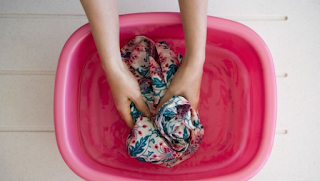Can you clean a garment that is hand wash only on the Delicate Cycle in a washing machine? You could, but should you? Definitely not. If in doubt, bring your item to a Professional Dry Cleaners like Comet Cleaners in Denton, Texas for our expert treatment.
It has long been a myth that hand washing and machine washing on a delicate cycle were the same thing when, in fact, they are very different. Sure, many people have taken the risk of machine washing a garment and had it be a success, but just as many have failed.
Hand washing properly is a process that uses as little agitation as possible. The cleaning that is done is primarily from gentle soap action or water. Machine washing primarily uses agitation. Agitation is when clothes rub against other clothes creating a friction or scrubbing effect that gets dirt and grime out.
 Clothes who's care labels state that hand washing is the only
acceptable cleaning methods are usually too delicate to handle this
scrubbing action.
Clothes who's care labels state that hand washing is the only
acceptable cleaning methods are usually too delicate to handle this
scrubbing action.
Here's Why: Machine washing can cause tearing of fibers on a microscopic level which can cause holes and warping to develop. Even if it's not initially evident, these tiny tears can manifest months later as a hole that you have no clue how it got there.
Here are a few tips on hand washing your clothes:
- Try to always use cold water, not longer than lukewarm if you have to.
- Make sure the sink is clean, or better yet have a tub used only for hand washing.
- If there is a stain, pre-treat with a gentle soap and rub lightly with a finger. Submerge in the water to rinse, repeat as needed.
- If the item is extremely dirty it is better to let it soak overnight than risk over working the fabric.
- If washing more than one piece, only wash like colors at the same time. If the items are different colors, wash one at a time using fresh water between color changes.
Better yet, bring them to us at one of our three locations Comet Cleaners of Denton, Texas. We hand wash fine garments all the time!







